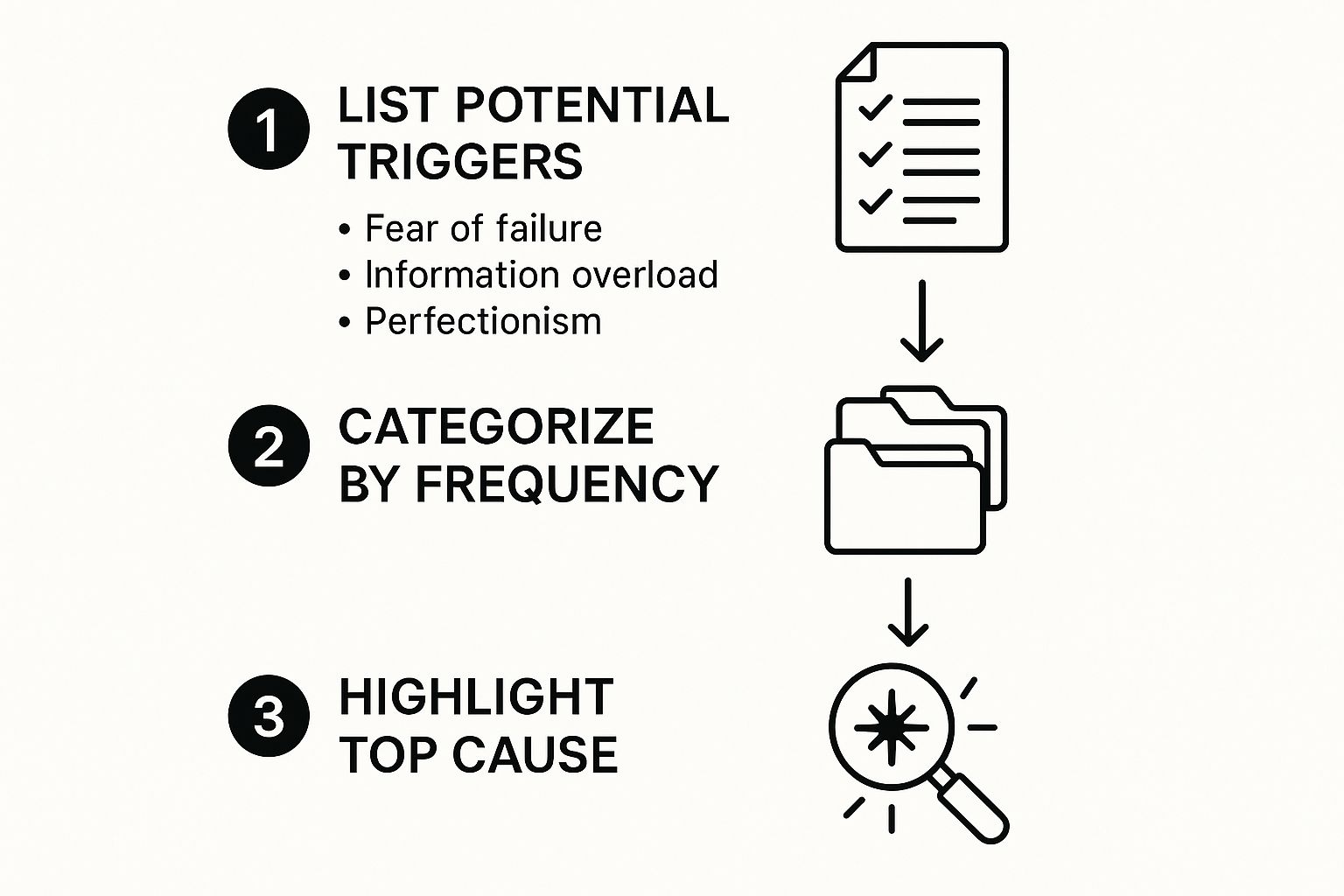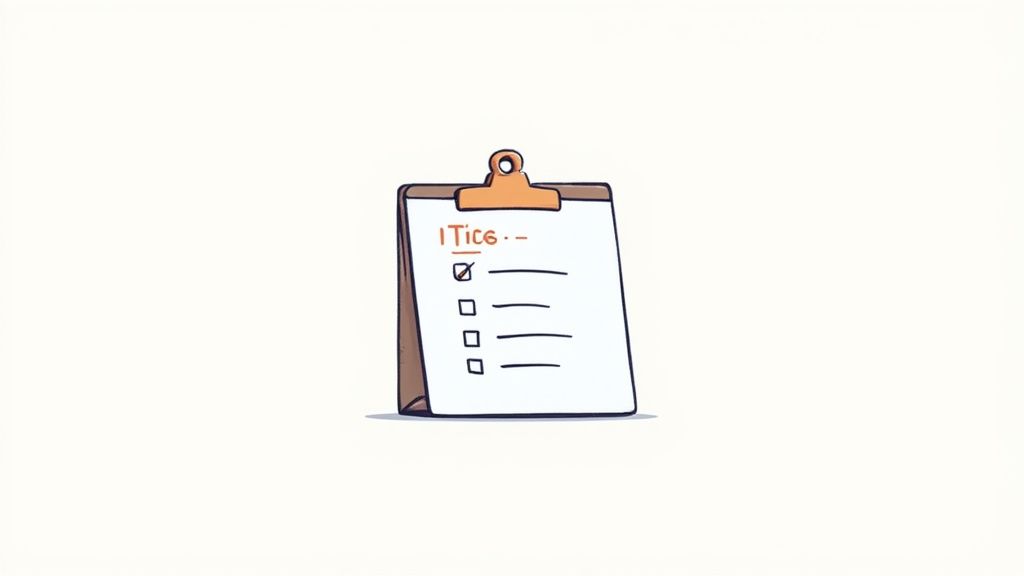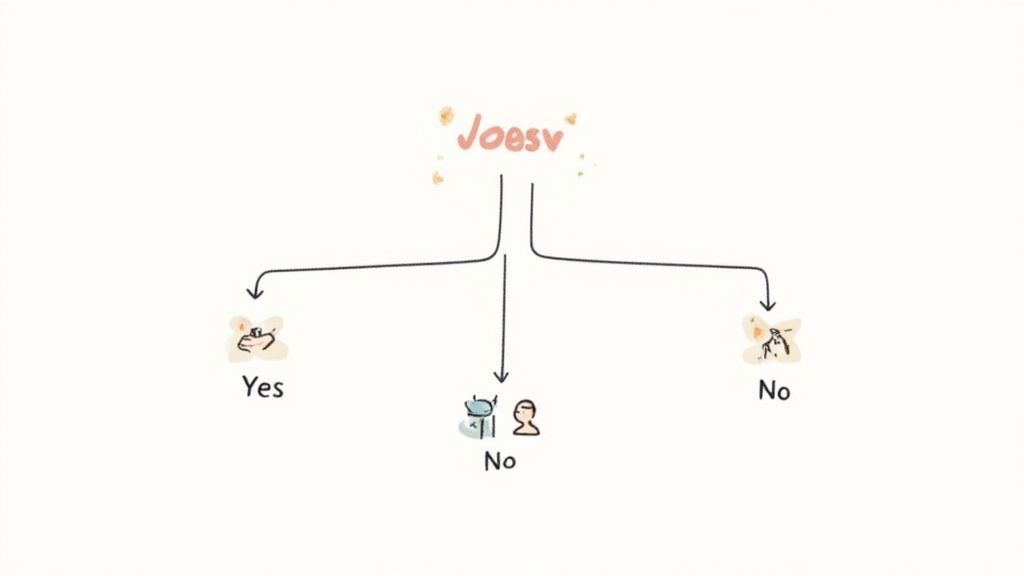How to Overcome Analysis Paralysis and Take Action

It's an exhausting feeling, getting stuck in a loop of overthinking. We've all been there. This cognitive trap is usually fueled by a nasty combination of information overload, perfectionism, and a genuine fear of making the wrong move.
The most important thing to realize is that analysis paralysis is a pattern, not a personal flaw. Recognizing it is the first step toward finally breaking free.
What Causes Analysis paralysis and How to Spot It

Analysis paralysis is what happens when you think about a decision so much that you become completely unable to act. Instead of moving forward, you're frozen, endlessly weighing every possible option and outcome. This isn't just being indecisive; it’s a vicious cycle where chasing the "perfect" choice prevents you from making any choice at all.
This phenomenon is incredibly common, especially in professional settings. A 2023 global survey found that a staggering 72% of business leaders admit to suffering from analysis paralysis, mostly due to overwhelming data. They get stuck because they can't separate the critical insights from all the noise. You can discover more about how data overload impacts decision-making and its effects.
The Psychological Triggers Behind Indecision
A few core psychological drivers are usually responsible for pulling you into this state. If you can understand them, you can start to spot the pattern in your own workflow.
Here’s a quick look at the most common triggers, what they feel like in the moment, and the real fear driving them.
Common Triggers of Analysis Paralysis
Fear of Making the Wrong Choice
Procrastinating on a decision, hoping for a "sign" or more certainty. You feel that doing nothing is safer than taking a risk.
Fear of regret, failure, or negative consequences.
Information Overload
Spending hours researching, gathering more and more data, and feeling like you can't possibly decide until you've seen everything.
Fear of missing a crucial piece of information that would lead to a better outcome.
Perfectionism
Searching for the one "flawless" option that doesn't exist. You get stuck because no choice meets your impossibly high standards.
Fear of being judged for making a sub-optimal choice or not living up to an ideal.
Understanding these triggers is the first step to recognizing when productive analysis has turned into paralyzing inaction.
The real problem with analysis paralysis is that it often masquerades as diligence. You tell yourself you're being thorough and responsible by gathering more data, but in reality, you've blown past the point of productive analysis and are stuck in neutral.
Real-World Scenarios of Analysis Paralysis
Think about a product team that gets stuck endlessly analyzing user feedback. They keep tweaking minor features, running "just one more" A/B test, and delaying the launch because they're chasing a mythical "perfect" product. It’s a classic case of analysis paralysis killing momentum.
Or picture a solo entrepreneur trying to pick a marketing platform. They spend weeks comparing features, reading every review, and watching countless tutorials. The fear of choosing a tool that isn't the absolute best for every hypothetical future scenario stops them from picking one and actually starting their marketing.
In both situations, the cost of the delay is far greater than the risk of making a "good enough" decision and moving on. This is where tools like Obsibrain can make a huge difference. For the product team, all user feedback, test results, and meeting notes can be centralized. They can then query this data to ask, "What are the top 3 requested features from users who have been active for more than 90 days?" This query provides focused, actionable data, breaking the cycle of endless analysis.
Actionable Frameworks for Decisive Thinking
Knowing why you're stuck in analysis paralysis is a great first step, but what really gets you moving are practical tools to break free. It's time to move beyond theory and adopt a few repeatable frameworks that actually train your brain for action. These aren't complicated strategies; they're simple mental models designed to cut through the noise and simplify your choices.
The whole point is to shift your focus. Stop searching for the single "perfect" answer and start making a "good enough" decision that lets you build momentum. A big part of that is learning to tell the difference between the decisions that truly matter and the ones that just feel like they do.
Differentiate with the Two-Way Door Method
One of the most powerful ways to overcome analysis paralysis is to start sorting your decisions. Jeff Bezos has a famous mental model for this: the "one-way" vs. "two-way" door.
One-Way Doors: These are the big ones—high-stakes, irreversible decisions. Think about making a huge financial commitment or a major strategic pivot for your business. These choices absolutely deserve slow, careful thought.
Two-Way Doors: This is where most of our decisions actually live. They're reversible. If you make a less-than-ideal choice, you can simply walk back through the door, learn something from the experience, and try another path. The long-term damage is minimal.
Getting bogged down on a two-way door decision is where analysis paralysis loves to strike. Once you realize a choice isn’t permanent, that immense pressure to get it right on the first try just melts away. This frees you up to act, gather some real-world feedback, and adjust, instead of getting lost in endless "what if" scenarios.
This infographic lays out a simple process for figuring out what causes your own decision-making bottlenecks.

By writing down your triggers—like perfectionism or information overload—and sorting them, you can zero in on the main driver that needs your attention.
Embrace "Good Enough" with Satisficing
Another fantastic framework is satisficing, which is a mashup of "satisfy" and "suffice." In short, it means you pick the first option that meets your core, essential criteria instead of endlessly hunting for the absolute best possible choice out there. Perfectionism is a huge cause of paralysis, and satisficing is its perfect antidote.
Let's say you need a new project management tool. You could easily blow weeks comparing dozens of platforms, getting lost in niche features you'll probably never even touch.
Instead of aiming for the perfect tool, just define your three to five non-negotiable requirements. Does it have to integrate with Slack? Is a calendar view a must-have? The second you find a tool that checks those essential boxes, make the call and move on.
This approach keeps you from drowning in unnecessary details. When you're dealing with scattered information and the stress of not knowing what to do next, looking into proven startup marketing strategies can also give you a clear path by focusing on what works, not just what's possible.
For a more integrated system, you can manage this whole decision-making process inside Obsibrain. Create a note called "Project Management Tool Decision," then create a checklist of your non-negotiable criteria (e.g., "Slack Integration," "Mobile App," "Under $15/user/month"). As you research, you link potential tools and check off the criteria they meet. The first tool that satisfies all your non-negotiables is the winner. This turns a complex evaluation into a simple, structured task. Obsibrain is built to turn thoughts into concrete actions, which is exactly what you need to build more decisive habits. You can check out its action-oriented features to see how it supports this kind of workflow.
Using Technology to Cut Through the Noise
Modern tools can either add to the chaos or bring powerful clarity. The real trick is making technology your ally against information overload, not just another source of distraction. When you're stuck trying to figure out how to overcome analysis paralysis, the right system can turn a mountain of data into something you can actually use.
Imagine you're a founder juggling investor emails, market research, and product roadmaps. The data is everywhere—scattered across different apps, documents, and platforms. It’s nearly impossible to see the big picture. This is exactly where a centralized knowledge base becomes a lifesaver.
Taming Information Overload with a Second Brain
Instead of letting scattered information paralyze you, what if you could feed all of it into a single tool designed to connect the dots? This is the core idea behind the "second brain" approach, and it’s where a tool like Obsibrain really shines. It gives you a single source of truth for all your projects and decisions.
You stop wasting precious mental energy just trying to remember where everything is. Instead, you can start using that energy to think strategically. A well-organized system acts as a filter, helping you zero in on the information that actually matters for the decision at hand.
The goal isn't just to store information but to synthesize it. Technology should help you ask better questions and get clearer answers, turning raw data into a solid foundation for your next move.
For instance, you can pull all that disparate information into Obsibrain and start asking direct, powerful questions. This is where you can begin to see connections between ideas that were invisible before.

This kind of visual approach makes it so much easier to spot patterns and relationships you would otherwise miss. Suddenly, complexity starts to look a lot more like clarity.
A Practical Use Case for Obsibrain
Let's circle back to our founder. Instead of spending hours manually sifting through hundreds of emails and reports, they can now simply ask Obsibrain:
"Based on recent user feedback, what are the top three customer-requested features?"
"Summarize the key risks highlighted in our last five board meetings."
"What are the main competitor weaknesses mentioned in our market research notes?"
Suddenly, that overwhelming mess of data delivers synthesized, actionable answers. This method dramatically cuts down the cognitive load that comes with making big decisions. Rather than drowning in details, you’re handed the core insights needed to move forward with confidence.
This frees up your mental bandwidth to focus on the strategic decision itself, not the tedious grunt work of gathering information. You can see how this works by exploring Obsibrain's features for task management, which help turn those fresh insights into concrete, executable plans.
By letting technology do the heavy lifting of organization and synthesis, you create an environment where decisive action is the natural next step. For anyone struggling with how to overcome analysis paralysis in a data-rich world, this is one of the most effective strategies out there. You’re no longer just collecting data; you’re using it to build momentum.
The Real Cost of Indecision at Work
Analysis paralysis isn’t just some personal quirk that kills your own productivity. It’s a silent poison for your entire organization. When a leader gets stuck in the weeds, overthinking a decision, the ripple effect can stall projects, frustrate your best people, and grind all momentum to a halt.
That hesitation quickly becomes a bottleneck. Suddenly, your top performers—the ones ready to execute and drive things forward—are just sitting on their hands, waiting. The impact isn't just about missing a few deadlines; it starts to chip away at the very foundation of what makes a team great.
How It Wrecks Team Dynamics
When decisions are constantly kicked down the road, morale takes a nosedive. Your most ambitious and proactive employees start to feel like they’re running in mud, which is a fast track to disengagement and burnout. Why bother bringing creative, innovative ideas to the table if they’re just going to get stuck in an endless review cycle?
You end up transforming a culture of action into one of timidly waiting for permission. Research backs this up, showing that delayed decisions lead to a whole host of problems: procrastination, a nosedive in creativity, and even more team conflict. Over time, this is how a high-performing team slowly becomes a low-performing one. You can dig deeper into how indecision impacts team effectiveness and the health of an organization.
A leader's paralysis doesn't just pause progress; it teaches the team that hesitation is the norm. It quietly signals that caution is valued more than action—a dangerous mindset in any competitive market.
From Bottleneck to Genuine Business Risk
The fallout from this paralysis goes way beyond internal team drama; it becomes a tangible business risk. While you’re busy mapping out every conceivable outcome of a decision, your more agile competitors are already out there acting, testing, and learning from the real world. They’re busy capturing market share that could have been yours.
This reframes analysis paralysis from a simple bad habit into a critical leadership failure. Every delayed product launch, every postponed marketing campaign, every unresolved strategic question is a missed opportunity. The cost isn’t just measured in wasted hours but in lost revenue, a weakened competitive edge, and—worst of all—the potential exit of your most valuable people.
This is where a tool like Obsibrain can be a game-changer for leadership. A project lead can create a dedicated note titled "Q3 Marketing Campaign Decision," linking all relevant research, budget options, and team feedback. By setting a hard deadline as a task within the note and assigning the decision to a specific person, you create clear ownership and a timeline. This structured approach forces clarity and builds an audit trail, turning a chaotic evaluation into a manageable and transparent process.
Building Long-Term Habits for Confident Decisions

Escaping analysis paralysis for good isn’t about quick fixes. It's about building new mental muscles. The real goal is to cultivate a resilient, action-oriented mindset where making confident decisions becomes your default setting. This is how you and your team stay agile for the long haul.
One of the most powerful habits you can build is the 'pre-mortem'. Forget the traditional post-mortem where you pick apart what went wrong after the fact. Instead, before a big project even starts, imagine it has already failed spectacularly. Your team then works backward to list every possible reason for this imaginary disaster.
This simple shift in perspective turns a vague fear of failure into a practical checklist of risks you can actually manage. It lets you anticipate challenges without getting stuck, converting that anxiety into a concrete action plan.
Creating a Culture of Action
Building better habits isn't just a solo mission; it thrives in a supportive environment. If you're a leader, this means fostering a team culture that values informed action over endless deliberation. Encourage your team to make smaller, reversible decisions quickly and learn from what happens.
This has become even more crucial with the rise of hybrid and remote work. Team members are often drowning in data from a dozen different tools, which just fuels indecision. To fight this, you need to establish clear communication protocols and define who has the authority to make decisions.
True agility isn't about never making a mistake. It's about creating a system where you can make them, learn from them, and recover quickly without losing momentum. This builds psychological safety, which is the bedrock of decisive action.
To make this culture stick, get in the habit of celebrating incremental progress. When you acknowledge the small wins, you build momentum. It proves that movement—not perfection—is what really drives success. Every step forward becomes proof that action beats inaction every time.
Tracking Habits for Lasting Change
Consistency is what turns a conscious effort into an unconscious skill. This is where a personal system can make all the difference. Using a platform like Obsibrain helps you embed these new decision-making routines right into your daily workflow.
For example, you can create a daily recurring task in Obsibrain called "Make One 'Two-Way Door' Decision" or a weekly habit tracker for "Conduct a Pre-Mortem for a Key Project." Seeing your progress visually reinforces the new neural pathways you're building, making it easier to stick with the changes until they're second nature.
Check out our guide on tracking habits within Obsibrain to see how you can systematically build a more decisive mindset.
Got Questions? We've Got Answers
It can be tough to know when you're being careful and when you're just stuck. Let's tackle some of the most common questions people have about breaking free from analysis paralysis.
How Can I Tell if it's Productive Research or Just Paralysis?
This one's a classic. The short answer is momentum.
Careful research always moves forward. You're gathering info to answer specific questions, and every new piece of data should bring you a step closer to making a call. Analysis paralysis, though, feels like you’re stuck on a treadmill.
You find yourself re-reading the same articles, hunting for just one more opinion, or getting bogged down in tiny details that won't really change the outcome. If you feel more confused now than when you started, you're probably not progressing—you're paralyzed.
The real test is progress. If your research isn't actively helping you narrow down options or building your confidence, it has turned into a fancy form of procrastination.
Is it Ever a Good Idea to Delay a Decision?
Yes, but with a big asterisk. Delay is only smart for those massive, truly irreversible decisions—the "one-way doors" we talked about earlier. For choices like those, you absolutely need to be diligent.
But analysis paralysis itself is never a good thing. It means you're stuck well past the point of productive thinking.
The goal is to be deliberate, not indefinitely delayed. For those huge decisions, use a decision-making framework and set a hard deadline. This keeps your thoroughness from becoming an excuse for never making a move.
I'm Stuck. What's the Very First Thing I Should Do?
Do something small. Something physical. Don't even try to solve the whole problem.
Just ask yourself, "What is one tiny thing I can do in the next 10 minutes to nudge this forward?"
It could be as simple as:
Drafting one quick email to a team member.
Outlining just the intro of that proposal.
Blocking 30 minutes on your calendar for the final decision.
This tiny action shatters the inertia of overthinking. It creates just enough momentum to help you take the next, slightly bigger step.
Can a Team's Culture Actually Cause Analysis Paralysis?
Oh, absolutely. A culture that penalizes mistakes, operates without clear priorities, or demands consensus from a dozen people is the perfect breeding ground for analysis paralysis. When people are terrified of making the "wrong" choice, they'll simply avoid making any choice at all.
The healthiest cultures empower their teams to make reversible decisions fast and learn from whatever happens.
This is exactly where a tool like Obsibrain can make a huge difference. A manager can create a "Decision Log" space where each choice is documented with its rationale and outcome. This transparency shows the team that decisions are part of a learning process, not a final judgment. It helps build psychological safety by valuing informed action and learning over fearful waiting.
Ready to swap scattered thoughts for decisive action? Obsibrain is the all-in-one system built to help you centralize notes, manage your tasks, and build the habits you need to leave analysis paralysis behind for good.
Start making confident decisions today by visiting https://www.obsibrain.com/en.
Last updated
Was this helpful?